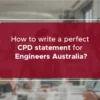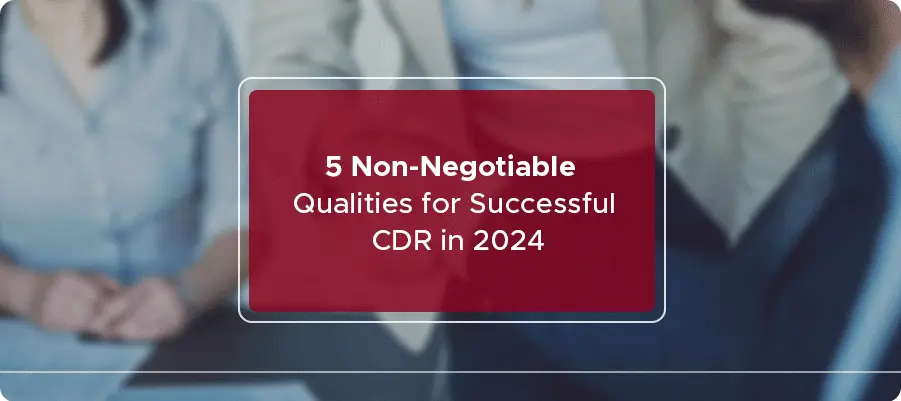
How to prepare CPD for your CDR Report?
For engineers seeking recognition and employment opportunities in Australia, the Competency Demonstration Report (CDR) is a crucial document. It serves as a means to demonstrate your engineering skills, qualifications, and competencies to Engineers Australia (EA), the assessing authority for skilled migration.
A key component of the CDR is the Continuing Professional Development (CPD) section, where you showcase your commitment to lifelong learning and professional growth. In this comprehensive guide, we will delve into the intricacies of preparing a compelling CPD for your CDR report, ensuring that your application stands out among the competition.
Components of Continuing Professional Development (CPD)
The Continuing Professional Development (CPD) component of the CDR Report holds a distinct significance in the realm of engineering excellence and career progression. It serves as a testament to an engineer’s commitment to lifelong learning, proactive skill enhancement, and staying abreast of the dynamic advancements within their chosen engineering discipline.
This section of the CDR not only showcases an engineer’s dedication to professional growth but also aligns with the core principles upheld by Engineers Australia (EA), the assessing authority responsible for evaluating the competency of aspiring engineers.
CPD, at its essence, embodies the philosophy that the journey of learning and improvement does not conclude with the attainment of an engineering degree or professional certification. Rather, it signifies a continuous voyage, where engineers consistently seek to refine their skills, deepen their knowledge, and broaden their horizons.
As such, the CPD component transcends being a mere mandatory requirement; it encapsulates the essence of what it means to be a forward-thinking, adaptable, and progressive engineer. The CPD component encompasses several fundamental aspects, each contributing to the holistic demonstration of an engineer’s commitment to professional development:
1. Description of Activities
At the heart of the CPD component lies a comprehensive account of the diverse activities an engineer has engaged in over the past three years. These activities span a wide spectrum, including but not limited to workshops, seminars, conferences, formal courses, webinars, technical discussions, collaborative projects, and self-directed research.
The purpose of detailing these activities is not just to list them, but to provide a clear narrative that highlights the proactive efforts taken to enhance one’s engineering competencies.
2. Duration
The duration of each CPD activity serves as a quantitative measure of the depth of an engineer’s engagement. It reflects the investment of time and effort dedicated to each activity. While longer durations may indicate a substantial commitment, shorter activities may be equally impactful in terms of knowledge gained and insights acquired.
Therefore, the duration adds a layer of context to the overall CPD portfolio.
3. Relevance to Engineering
For each CPD activity described, it is imperative to articulate its direct relevance to the engineer’s specific engineering discipline.
This relevance could manifest in various ways, such as aligning with the engineer’s field of expertise, addressing key competencies outlined by Engineers Australia, or contributing to the practical application of engineering principles. This alignment underscores the engineer’s ability to bridge theoretical knowledge with real-world challenges.
4. Reflection
The reflective aspect of the Continuing Professional Development (CPD) component is pivotal. Engineers are not just expected to attend activities but to introspect and elucidate on how each activity has influenced their professional journey.
This reflection delves into how newfound knowledge has been integrated into their work, projects, problem-solving strategies, and overall engineering practice. Sharing tangible examples of applications enhances the authenticity of the CPD account.
5. Future Goals
A glimpse into the future is an integral part of the CPD component. Engineers are encouraged to outline their aspirations and intentions regarding future CPD endeavors. This forward-looking perspective demonstrates a proactive approach to professional development and underscores a commitment to sustained growth.
The alignment of these goals with the engineer’s overarching career trajectory emphasizes a strategic mindset. It is worth noting that Engineers Australia has set forth certain expectations and guidelines for the CPD component, emphasizing the importance of quality over quantity.
While documenting a multitude of activities may seem appealing, the genuine impact of a few well-chosen activities often holds more weight. Engineers are encouraged to focus on activities that hold substantial significance to their field, ensuring a deep exploration of topics that contribute meaningfully to their knowledge base and competencies.
Moreover, Engineers Australia recognizes two broad categories of Continuing Professional Development (CPD): Formal and Informal. Formal CPD encompasses structured activities, often organized by professional bodies, institutions, or recognized providers.
These activities typically include workshops, courses, and conferences. Informal CPD, on the other hand, encompasses self-directed learning, technical discussions, research, and other activities that engineers undertake on their initiative.
In essence, the CPD component of the CDR is a testament to an engineer’s unwavering commitment to growth, adaptability, and resilience in the face of an ever-evolving engineering landscape. It embodies the spirit of exploration, the pursuit of knowledge, and the dedication to applying that knowledge to real-world challenges.
As engineers embark on the journey of compiling their CPD for their CDR report, they are not just fulfilling a requirement but are capturing the essence of their professional identity and their contribution to the world of engineering.
Learn More: How to write and lodge an Expression of Interest (EOI) effectively? 🧑🏽✈️🏆
Importance of CPD
Continuous Professional Development (CPD) is a cornerstone of success and growth in the engineering profession. It encompasses a series of purposeful and structured activities that enable engineers to enhance their knowledge, skills, and competencies throughout their careers.
CPD is not just a mandatory requirement; it is a commitment to lifelong learning and staying at the forefront of advancements in the dynamic field of engineering. The engineering landscape is constantly evolving, driven by technological innovations, emerging trends, and evolving industry standards.
To remain relevant and competitive, engineers must embrace CPD as an integral part of their professional journey. Here’s a closer look at the importance of CPD for engineers:
1. Adapting to Technological Advancement
The world of engineering is shaped by rapid technological progress. Engineers need to stay updated with the latest tools, software, and methodologies to deliver cutting-edge solutions. CPD allows them to acquire new technical skills and stay adept at utilizing advanced technologies, ensuring their work remains efficient and innovative.
2. Maintaining Relevance
As industries evolve, so do the demands on engineers. CPD enables professionals to adapt their skills to match the changing needs of their sector. Whether it’s incorporating sustainable practices, adhering to new regulations, or embracing digital transformation, CPD ensures engineers remain relevant and valuable contributors.
3. Enhancing Problem-Solving Abilities
Engineering is inherently about solving complex problems. CPD broadens an engineer’s problem-solving toolkit by exposing them to diverse perspectives and approaches. Attending workshops, seminars, and collaborative projects fosters critical thinking and enables engineers to approach challenges with creativity and ingenuity.
4. Meeting Professional Licensing Requirements
Many engineering bodies and regulatory authorities mandate CPD as a requirement for maintaining professional licenses. Engineers need to accumulate a certain number of CPD hours to demonstrate their commitment to competence and ethics. Failure to meet these requirements could jeopardize their ability to practice.
5. Boosting Career Opportunities
It showcases engineers’ dedication to self-improvement and growth, making them more attractive to employers. Professionals with a robust CPD record are often considered for promotions, leadership roles, and high-impact projects, contributing to long-term career advancement.
6. Networking and Knowledge Sharing
Events, such as conferences and workshops, provide valuable networking opportunities. Engaging with peers, experts, and industry leaders allows engineers to exchange insights, share best practices, and collaborate on innovative projects, fostering a culture of continuous learning.
7. Elevating Professional Reputation
A consistent commitment to CPD enhances an engineer’s reputation as a knowledgeable and skilled practitioner. This reputation not only benefits the individual but also bolsters the credibility of the engineering profession as a whole.
Learn More: How to write ACS RPL Report for Database Administrator? ⏱⌛️
Guidelines for Crafting Your CPD Section
Below are guidelines for crafting your CPD section:

1. Strategic Activity Selection
The main part of a compelling CPD section lies in the selection of activities. Engineers are advised to strategically choose activities that resonate with their engineering specialization and align with their career aspirations.
Be it attending workshops, seminars, online courses, or engaging in collaborative projects, each activity should contribute tangibly to the development of specific competencies.
2. Quality Over Quantity
While a comprehensive CPD portfolio is impressive, quality triumphs over quantity. A few impactful activities that have led to tangible skill enhancement and practical application hold more weight than an extensive list devoid of reflective insights.
3. Relevance to ANZSCO Code
Align your CPD activities with the ANZSCO code of your nominated occupation. This alignment substantiates the suitability of your skills for the Australian engineering industry, enhancing the credibility of your CPD section.
4. Reflective Writing
Embrace reflective writing as a powerful tool to elucidate how each CPD activity has influenced your professional practice. Delve into the specifics – how did the knowledge gained impact your problem-solving approach, project execution, or decision-making? Employ specific examples to illustrate these points and add depth to your reflections.
5. Future Goals and Aspirations
Outline your future CPD plans with clarity and purpose. This showcases your commitment to ongoing learning and sets a trajectory for your professional growth. Discuss how these future activities will complement your existing competencies and advance your career goals.
6. Engage with Engineers Australia Resources
Use resources offered by Engineers Australia at optimum to guide your successful journey. The “My Portal” platform facilitates the recording and management of your CPD activities, ensuring compliance with their requirements.
7. Diverse Learning Experiences
Opt for a diverse range of Continuing Professional Development activities, blending formal and informal learning. Engage in courses, workshops, conferences, technical discussions, and self-directed research to demonstrate versatility in your learning approach.
8. CPD Statement Crafting
As part of this section, craft a compelling statement that encapsulates your commitment to lifelong learning, the rationale behind your activity selection, and how these activities have contributed to your professional growth. This statement provides a holistic perspective on your CPD journey.
9. Proofreading and Review
After drafting your CPD section, meticulously review and proofread the content. Ensure clarity, coherence, and proper grammar. Seek feedback from mentors or colleagues to enhance the overall quality.
10. Illustrating the Guidelines through Examples
For instance, imagine an engineer specializing in civil engineering. To align with the ANZSCO code and demonstrate relevance, the engineer could attend a workshop on sustainable construction practices. In the CPD section, they could describe the workshop, and its duration, and articulate how the concepts learned have influenced their project designs, emphasizing eco-friendly solutions.
Furthermore, an engineer aiming to enhance project management skills could enroll in an accredited online course. The CPD entry could provide details about the course, and its duration, and delve into how the acquired knowledge has streamlined their project planning, resource allocation, and risk management processes.
Learn More: 12 things to consider while writing CPD for Engineers Australia ⏱⌛️
Engineers Australia CPD Types and Recording
Engineers Australia recognizes two main types of CPD: Formal and Informal. Formal CPD involves structured activities like workshops, conferences, and courses. Informal one encompasses self-directed learning, technical discussions, and research.
It’s essential to maintain a Continuing Professional Development log, recording each activity’s details, as Engineers Australia may request this documentation during the assessment process.
Continuing Professional Development Log Template
A well-organized CPD log helps you track your activities effectively. Here’s a template to consider:
| Date | Activity Description | Duration | Relevance to Engineering | Reflection | Future Goals |
|---|---|---|---|---|---|
| DD/MM/YYYY | Advanced Structural Design Seminar | 8 hours | Structural engineering | Learned new seismic design approaches. | Pursue geotechnical engineering course. |
| DD/MM/YYYY | Online Project Management Course | 20 hours | Project management | Improved project scheduling skills. | Attend risk management workshop. |
| DD/MM/YYYY | IEEE Technical Discussion: AI in IoT | 2 hours | Electrical engineering | Explored AI's impact on IoT. | Implement AI techniques in current project. |
Learn More: How IT Professionals can successfully migrate to Australia? ✈️✈️
Conclusion
The Continuing Professional Development section of your CDR holds immense significance in demonstrating your commitment to continuous learning and professional development. By following the steps outlined in this comprehensive guide, you can craft a compelling CPD that not only meets Engineers Australia’s requirements but also highlights your dedication to engineering excellence.
Remember, your CPD is a reflection of your journey as an engineer and your aspiration to contribute meaningfully to the Australian engineering landscape. Through careful planning, reflective writing, and strategic presentation, you can create a CPD section that enhances the overall impact of your CDR report and sets you on the path to success in your engineering career Down Under.





